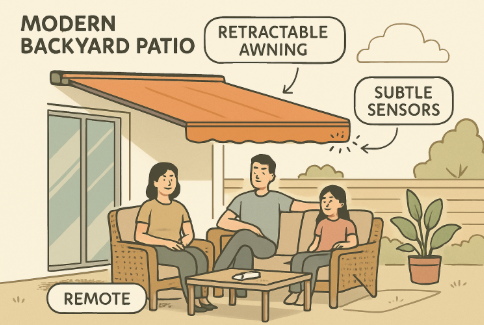Key Takeaways:
- Awnings enhance outdoor living by providing shade, comfort, and aesthetic appeal.
- Modern awnings incorporate innovative technology for convenience and energy efficiency.
- Customizable designs allow homeowners to tailor awnings to their specific needs and styles.
- Strategic awning placement can contribute to sustainable gardening and water conservation.
Enhancing Comfort and Usability
Awnings have experienced a remarkable transformation in recent years, going beyond their traditional use as basic sun shelters. Today’s awnings are synonymous with tailor-made comfort, allowing homeowners to make the most of their patios, decks, and gardens all year round. They significantly lower the heat and glare by offering critical shade, making even the hottest summer days enjoyable. This enhanced comfort means outdoor furniture and flooring are better protected from damaging UV rays—extending their lifespan and beauty.
Whether you’re looking to create the perfect spot for family gatherings, barbecues, or a tranquil getaway at home, the right awning dramatically increases the usability of any outdoor area. For those planning events or celebrations, you may even consider tent rentals Fairborn OH, for added flexibility and comfort.
Integrating Smart Technology
Technological advancements have brought a fresh wave of convenience to outdoor living. Modern awnings can be equipped with motorized controls, operating smoothly with remote devices or smartphone apps. Some awnings are linked to smart sensors that automatically open or retract in response to sunlight or windy conditions, helping protect the structure and maximizing energy efficiency. These systems can be synced with existing home automation platforms, seamlessly merging security, lighting, and climate control for a brilliant outdoor oasis.
Emerging trends in outdoor living highlight the efficiency of these innovations, as homeowners increasingly seek intelligent ways to enhance comfort and reduce daily chores. The New York Times explores this growing demand for sophisticated outdoor solutions, noting how smart awnings are redefining the concept of backyard relaxation.
Customization and Aesthetic Appeal
A significant advantage of modern awnings is their versatility in design. With options for color, material, shape, and even branding for commercial settings, awnings have become a vivid extension of a home’s identity. Homeowners no longer settle for one-size-fits-all solutions; customizable awnings are now available to complement any architectural style perfectly—from traditional homes to contemporary builds. This personalized approach boosts curb appeal and adds measurable value to the property.
As more people invest in curb-to-backyard design, outdoor customization has become a top priority. In fact, companies specializing in outdoor living are now offering design consultations and modular systems that adapt to unique needs, from privacy screens to retractable side panels for weather protection. For further inspiration on personalized awnings, Forbes details the best awning options for various lifestyles and climates.
Creating Seamless Indoor-Outdoor Transitions
Awnings transform the connectivity between indoor and outdoor spaces. By extending coverage over patios or decks, they create a natural flow from living rooms or kitchens into nature. This design strategy visually enlarges the living space and encourages everyday use of the outdoors, fostering a sense of relaxation and well-being. The smooth transition between environments lays the groundwork for versatile entertaining and increased home enjoyment.
Supporting Sustainable Gardening Practices
The sustainability benefits of awnings go beyond human comfort—they also play a meaningful role in garden health. By casting strategic shade during the hottest periods, awnings help regulate garden microclimates. This stabilizes soil temperature, minimizes evaporation, and reduces the need for frequent watering, which aligns with water conservation goals. In the long term, creating a sheltered garden environment helps plants thrive, lowers maintenance efforts, and supports eco-friendly landscaping initiatives.
Enhancing Energy Efficiency
Awnings act as a first defense against unwanted heat gain by shielding large windows and doors from direct sunlight. This translates into significantly lower interior temperatures and a diminished reliance on air conditioning throughout summer. According to the Department of Energy, properly placed awnings can reduce solar heat gain by as much as 65% on south-facing windows and 77% on west-facing windows. The result is substantial energy savings, lower utility bills, and reduced environmental impact over time.
Increasing Property Value
Investing in high-quality awnings is a strategic decision for homeowners seeking to enhance functional and financial value. Well-designed awnings instantly improve curb appeal by accentuating architectural features and creating inviting outdoor living areas. Real estate professionals confirm that homes with attractive and functional outdoor enhancements often command higher market prices and experience greater buyer interest—making awnings a lifestyle upgrade and a sound investment in the property’s future.
Conclusion
Awnings have evolved into versatile, high-impact upgrades for outdoor living spaces. Whether driven by innovative technology, custom design, sustainability, or energy efficiency, these innovations provide tangible benefits to homeowners seeking comfort, value, and style. Thoughtfully chosen and strategically installed awnings can transform everyday life, building a bridge between indoors and out while contributing to a more beautiful, sustainable home environment.

